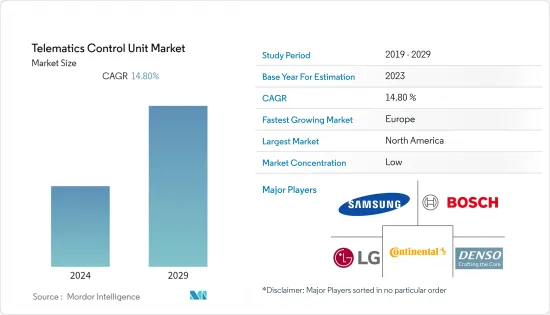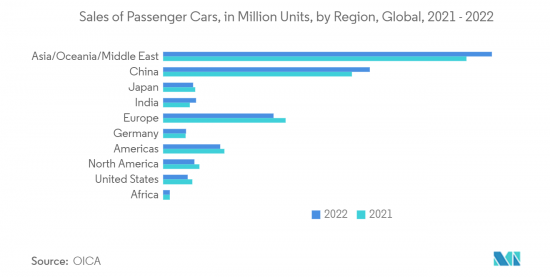 |
市場調查報告書
商品編碼
1404351
遠端資訊處理控制單元 -市場佔有率分析、產業趨勢/統計、2024-2029 年成長預測Telematics Control Unit - Market Share Analysis, Industry Trends & Statistics, Growth Forecasts 2024 - 2029 |
||||||
※ 本網頁內容可能與最新版本有所差異。詳細情況請與我們聯繫。
上年度,遠端資訊處理控制單元市場價值為38.5億美元,預計在預測期內將達到88億美元,複合年成長率為14.8%。

主要亮點
- 遠端資訊處理是汽車產業使用的一種通訊系統,依賴透過無線網路與車輛交換資料。汽車產業正進入無線技術、資訊技術和汽車電子結合的資訊時代。
- 資料在汽車單元中產生並通訊到後勤部門系統,或後勤部門系統將地圖、庫存更新、天氣預報、網路資料封包等資料推送到汽車單元。這種互動是透過行動電話或安裝在車輛上的裝置進行的。汽車依靠行動電話塔矩陣和衛星技術進行通訊並繪製其行蹤地圖。該技術由遠端資訊處理控制單元整合和控制。
- 遠端資訊處理控制單元最近已成為汽車行業的重要組成部分。遠端資訊處理控制單元(TCU)的採用率較低。聯網汽車的概念仍處於階段,很少有汽車公司涉足聯網汽車。然而,隨著 5G 和自動駕駛汽車的出現,聯網汽車的範圍可能會擴大。根據 Appinventiv 的數據,聯網汽車預計將成為全球 5G 物聯網端點市場的最大細分市場,預計到年終將有 1,900 萬個端點。
- 遠端資訊處理控制單元透過引入額外的數據機和處理器來增強車輛的連接性,從而實現從汽車到雲端、基礎設施或其他車輛的通訊。它還透過改進的電流感應、診斷和噪音抑制來實現天線功率最佳化。它還產生車輛營運每個組成部分的數位藍圖,使車隊經理能夠評估可以在哪裡應用它們來預防事故並執行駕駛員安全法規。此外,遠端資訊處理控制單元可以透過分析使用時間資訊、記錄維護檢查計劃、保固召回、引擎工時追蹤和服務記錄追蹤來幫助維護。
- 然而,已開發地區認知度低、新興市場和低度開發地區客戶的價格敏感性以及與遠端資訊處理控制單元相關的網路安全威脅等因素繼續對研究市場的成長構成挑戰。此外,缺乏遠端資訊處理解決方案的通用全球法規結構也對所研究市場的成長構成挑戰。
- COVID-19 大流行對所研究市場的成長產生了重大影響。預計此次疫情將對市場成長產生長期影響,因為隨著營運最佳化和燃油監控需求的增加,車隊營運商和車隊所有者顯著加速了對遠端資訊處理技術(例如遠端資訊處理控制單元)的接受。大流行也增加了對遠端車輛監控解決方案的需求。疫情期間,車隊營運商無法再投入人力資源進行車隊管理。在新冠疫情之後,對更好地追蹤資產的需求不斷成長,對車輛安全和自動駕駛汽車的需求不斷成長,這可能會在未來幾年為調查市場帶來重大推動力。
遠端資訊處理控制單元市場趨勢
小客車佔市場主導地位
- 小客車是指載客數(含駕駛)8人以下的小型、中型、大型車輛。安裝在小客車中的遠端資訊處理控制單元 (TCU) 可用於多種用途,包括緊急服務通知、失竊車追蹤和遠端車輛固定。 TCU收集和傳輸車輛診斷資料,從而實現遠端監控和分析。這有助於預防性維護、識別潛在問題並提高車輛的整體性能。
- TCU 通常用於小客車車隊管理系統,以監控和追蹤車輛位置、性能和使用情況。這使您可以最佳化路線並監控駕駛員行為和整體車輛效率。它還向保險公司提供車輛資料,以支援資訊娛樂連接、導航和地圖繪製。
- 電動車的普及正在推動小客車需求的擴大。隨著政府和個人優先考慮永續性,人們開始轉向更清潔的交通途徑。例如,根據 IEA 的數據,純電動車的全球銷量預計將從 2021 年的 460 萬輛增加到 2022 年的 730 萬輛。 2021年銷量將比2020年成長一倍以上,2022年電動車銷量將創下新紀錄。此外,許多國家不斷壯大的中階增加了購買力和對小客車的需求。
- 根據OICA(國際工業協會)的數據,中國是全球最大的汽車市場。 2022年,中國汽車用戶購買了約2,356萬輛小客車,使印度成為亞洲第二大小客車市場。
- 在汽車工業中,生產的小客車數量不斷增加。例如,根據經濟分析局 (BEA) 的數據,2022 年美國將生產約 180 萬輛汽車。與 2021 年相比,增加了約 13%。這些新興市場的開拓可能會支持目標市場的成長。

北美佔最大市場佔有率
- 由於對汽車產業和尖端技術的投資不斷增加,北美已成為研究市場的主要投資和採用國家之一。遠端資訊處理控制設備應用於各個領域,為汽車產業提供安全、舒適和便利。
- 在美國,汽車OEM數量眾多,普通購車者的技術意識較高,對汽車資訊娛樂和遠端資訊處理的偏好,4G/5G、電動車、聯網汽車的普及,預計將成為該地區聯網汽車的重要市場,部分原因是自動駕駛汽車銷售的增加。
- 據 KBB 稱,2023 年第一季美國售出近 258,900 輛純電動車。與2022年第一季的銷售額相比,年增約44.9%。
- 主要行業參與者增加研發投資、網際網路普及上升、資料成本下降、5G 的可用性、越來越多的客戶更喜歡連接性而不是車輛的機械規格,以及對電動車和自動駕駛汽車的需求增加。高峰銷售正在創造需求汽車和運輸產業,這可能會進一步推動該地區的研究市場。
遠端資訊處理控制單元產業概況
遠端資訊處理控制單元(TCU)市場的特點是高度分散,主要企業包括 LG 電子公司、三星電子(哈曼國際)、羅伯特博世有限公司、大陸集團和電裝公司。為了加強市場競爭,公司正在採取聯盟和收購等策略來擴大產品系列。
2023年3月,LG電子公司宣布一項重要進展:其越南研發中心將正式成為研發子公司。該子公司將在車輛資訊娛樂 (IVI) 系統軟體的開發和評估方面發揮關鍵作用。 IVI 系統包括視訊、遠端資訊處理、音訊和導航 (AVN) 解決方案,是未來移動出行的重要技術。此外,該子公司將促進提供各種與駕駛相關的資訊和娛樂功能。
2022 年 12 月,Ficosa 透過加入 SELFY聯盟來展示其對推進汽車技術的承諾,這是一個開創性計劃,旨在使自動駕駛和聯網汽車更能抵禦網路攻擊和緊急情況。我做到了。該聯盟的總體目標是設計能夠產生、監控和收集資料以有效識別潛在威脅的協作工具。這項努力將增強該產業應對網路威脅和其他潛在服務中斷的能力。透過該舉措開發的工具可以保護自主和互聯移動系統的隱私、機密性和完整性,並準備為汽車行業帶來重要的技術進步。
其他福利
- Excel 格式的市場預測 (ME) 表
- 3 個月的分析師支持
目錄
第1章簡介
- 研究假設和市場定義
- 調查範圍
第2章調查方法
第3章執行摘要
第4章市場洞察
- 市場概況
- 產業吸引力-波特五力分析
- 供應商的議價能力
- 買方議價能力
- 新進入者的威脅
- 替代品的威脅
- 競爭公司之間的敵對關係
- 技術簡介
- 宏觀趨勢對市場形勢的影響
第5章市場動態
- 市場促進因素
- 汽車產業對安全性、舒適性和便利性的需求不斷成長
- 5G技術的普及
- 市場抑制因素
- 發展中地區的遠端資訊普及下降
- 監管制裁的延遲
- 連結技術趨勢(2G/3G、4G、5G)
第6章市場區隔
- 按用途
- 安全保障
- 資訊和導航
- 其他用途
- 按類型
- 嵌入式OEM
- 售後服務
- 按車型
- 小客車
- 商用車
- 按地區
- 北美洲
- 歐洲
- 亞太地區
- 拉丁美洲
- 中東/非洲
第7章競爭形勢
- 公司簡介
- LG Electronics Inc.
- Samsung Electronics Co. Ltd(Harman International)
- Robert Bosch GmbH
- Continental AG
- Denso Corporation
- Marelli Europe SPA
- Visteon Corporation
- Valeo SA
- Ficosa International SA
第8章投資分析
第9章 馬勒凱特的未來

The telematics control unit market was valued at USD 3.85 billion in the previous year and is expected to register a CAGR of 14.8%, reaching USD 8.80 billion over the forecast period.
Key Highlights
- Telematics is a communication system employed in the automotive industry that depends on data traveling to and from automobiles over wireless networks. The automobile industry is being propelled into the information age by combining wireless technology, location technology, and in-vehicle electronics.
- Data is either generated in the vehicle unit and communicated to the back-office systems, or the back-office systems push data to the vehicle unit like maps, stock updates, weather reports, internet data packets, etc. This exchange occurs by cellphone or the unit installed in the vehicle. The car communicates and maps its whereabouts utilizing a matrix of cellphone towers and satellite technologies. This technology is incorporated into and controlled by a telematics control unit.
- The telematics control unit has recently become a crucial component in the automobile industry. The adoption of telematics control units (TCU) has been low. The concept of connected cars is still in its early stages, with very few automobile companies including them. However, the emerging prospects of 5G and autonomous vehicles will likely expand the scope of connected cars. According to Appinventiv, connected cars are anticipated to become the largest segment of the global 5G Internet of Things endpoint market, having a projected 19 million endpoints by the end of 2023.
- The telematics control unit facilitates increasing the vehicle's connectivity by introducing additional modems and processors to enable communication from the car to the cloud, infrastructure, or other vehicles. It enables antenna power optimization through improved current sensing, diagnostics, and noise reduction. It generates a digital blueprint of every component of a vehicle's operation, enabling fleet management to evaluate where enhancements in accident prevention and driver safety regulations can be applied. In addition, the telematics control unit can help with maintenance by analyzing hours-of-use information, planning maintenance inspections, and taking note of guaranteed recovery, engine hour tracking, and service records tracking.
- However, factors such as a lower awareness in developed regions, price sensitivity of customers in developing and less developed regions, and the cyber security threat associated with telematics control units continue to challenge the growth of the studied market. Furthermore, the lack of a common global regulatory framework for telematics solutions challenges the growth of the market studied.
- The global COVID-19 pandemic had a notable impact on the growth of the market studied. It is expected to have a long-term impact on the growth of the market as the pandemic significantly enhanced the acceptance of telematics technology, such as telematics control units, by fleet operators and vehicle owners as the need for operations optimization and fuel monitoring grows. The pandemic has also driven the demand for remote vehicle monitoring solutions, as, during the pandemic, fleet operators no longer had the luxury of deploying human resources to manage the fleet. The growing demand for better tracking of assets and the increasing push for vehicle safety and autonomous vehicles post-COVID will give a significant thrust to the market studied in the coming years.
Telematics Control Unit Market Trends
Passenger Vehicles to Dominate the Market
- Passenger cars are used for compact, mid-size, and full-size vehicles that convey not more than eight passengers (including the driver). The telematics control units (TCUs) in passenger vehicles can be used for several purposes: emergency services notification, stolen vehicle tracking, and remote vehicle immobilization. TCUs can collect and transmit vehicle diagnostics data, allowing for remote monitoring and analysis. This can help with proactive maintenance, identifying potential issues, and improving overall vehicle performance.
- TCUs are commonly used in passenger vehicles for fleet management systems to monitor and track vehicle location, performance, and usage of vehicles. This helps optimize routing and monitor driver behavior and overall fleet efficiency. They also provide vehicle data to insurance companies for enhanced infotainment connectivity, navigation, and mapping.
- The increasing adoption of electric vehicles contributes to the growing demand for passenger vehicles. As governments and individuals prioritize sustainability, there is a shift towards cleaner transportation options. For instance, according to IEA, global battery-electric vehicle sales reached an estimated 7.3 million in 2022, up from around 4.6 million in 2021. In 2021, these sales more than doubled compared to 2020, and 2022 marks a new record in all-electric sales volume. Moreover, the growth of the middle class in many countries has resulted in increased purchasing power and a higher demand for passenger vehicles.
- According to OICA (International Organization of Motor Vehicle Manufacturers), China is the world's largest automotive market. The Chinese motorists purchased approximately 23.56 million passenger cars in 2022, and India was the second-largest market for passenger cars in Asia.
- The automotive industry is also witnessing an increase in the production of passenger vehicles. For instance, according to the Bureau of Economic Analysis (BEA), in 2022, approximately 1.8 million automobiles were produced in the United States. It represents an increase of about 13 percent compared with 2021. Such developments are likely to boost the growth of the studied market.

North America Holds Largest Market Share
- North America is one of the significant investors and adopters in the studied market owing to growing investment in automotive sectors and the latest technologies. Telematics control unit devices are used in various regional verticals to provide Safety, Comfort, and Convenience in the Automotive Sector.
- The United States is anticipated to be the significant market for connected cars in the region due to the significant presence of automotive OEMs, high levels of technology awareness amongst the general car buyers, preference for infotainment and telematics in vehicles, widespread adoption of 4G/5G and increasing sales of electric, connected and autonomous cars in the country.
- According to KBB, in the first quarter of 2023, just under 258,900 battery-electric vehicles were sold in the United States. This year-over-year increase was around 44.9% compared to the sales recorded in the F1Q of 2022.
- The increasing investments in R&D by major industry players, rising Internet penetration, falling data costs, availability of 5G, growing preference of customers for connectivity features over mechanical specifications of cars, and a peak in sales of electric and autonomous automobiles are creating demand in the automotive and transportation industry may further propel the studied market in the region.
Telematics Control Unit Industry Overview
The telematics control unit (TCU) market is characterized by significant fragmentation, with major industry players including LG Electronics Inc., Samsung Electronics Co. Ltd (Harman International), Robert Bosch GmbH, Continental AG, and Denso Corporation. To strengthen their competitive position, companies in this market are employing strategies such as partnerships and acquisitions to augment their product portfolios.
In March 2023, LG Electronics Inc. announced a significant development, as its research and development center in Vietnam officially transformed into an R&D subsidiary. This subsidiary is poised to play a pivotal role in the development and evaluation of software for vehicle infotainment (IVI) systems. IVI systems encompass vital technologies for the future of mobility, encompassing video, telematics, audio, and Navigation (AVN) solutions. Additionally, this subsidiary will facilitate the provision of diverse driving-related information and entertainment functionalities.
In December 2022, Ficosa demonstrated its commitment to advancing automotive technology by participating in the SELFY consortium, a pioneering project aimed at enhancing the resilience of autonomous and connected vehicles against cyber-attacks and emergency situations. The consortium's overarching objective is to devise collaborative tools capable of generating, monitoring, and collecting data to identify potential threats effectively. This effort will strengthen the industry's ability to respond to cyber threats and other potential service disruptions. The tools developed through this initiative are poised to usher in a significant technological advancement in the automobile sector, safeguarding the privacy, confidentiality, and integrity of Autonomous and Interconnected Mobility Systems.
Additional Benefits:
- The market estimate (ME) sheet in Excel format
- 3 months of analyst support
TABLE OF CONTENTS
1 INTRODUCTION
- 1.1 Study Assumptions and Market Definition
- 1.2 Scope of the Study
2 RESEARCH METHODOLOGY
3 EXECUTIVE SUMMARY
4 MARKET INSIGHTS
- 4.1 Market Overview
- 4.2 Industry Attractiveness - Porter's Five Forces Analysis
- 4.2.1 Bargaining Power of Suppliers
- 4.2.2 Bargaining Power of Buyers
- 4.2.3 Threat of New Entrants
- 4.2.4 Threat of Substitute Products
- 4.2.5 Intensity of Competitive Rivalry
- 4.3 Technology Snapshot
- 4.4 Impact of Macro Trends on the Market Landscape
5 MARKET DYNAMICS
- 5.1 Market Drivers
- 5.1.1 Increase in Demand for Safety, Comfort, and Convenience in the Automotive Sector
- 5.1.2 Increased Deployment of 5G Technology
- 5.2 Market Restraints
- 5.2.1 Slower Rate of Penetration of Telematics in Developing Regions
- 5.2.2 Delayed Regulatory Sanctions
- 5.3 Connectivity Technology Trends (2G/3G Vs. 4G Vs. 5G)
6 MARKET SEGMENTATION
- 6.1 By Application
- 6.1.1 Safety and Security
- 6.1.2 Information and Navigation
- 6.1.3 Other Applications
- 6.2 By Type
- 6.2.1 Embedded OEMs
- 6.2.2 Aftersales
- 6.3 By Type of Vehicle
- 6.3.1 Passenger
- 6.3.2 Commercial
- 6.4 By Geography
- 6.4.1 North America
- 6.4.2 Europe
- 6.4.3 Asia-Pacific
- 6.4.4 Latin America
- 6.4.5 Middle East and Africa
7 COMPETITIVE LANDSCAPE
- 7.1 Company Profiles*
- 7.1.1 LG Electronics Inc.
- 7.1.2 Samsung Electronics Co. Ltd (Harman International)
- 7.1.3 Robert Bosch GmbH
- 7.1.4 Continental AG
- 7.1.5 Denso Corporation
- 7.1.6 Marelli Europe S.P.A.
- 7.1.7 Visteon Corporation
- 7.1.8 Valeo SA
- 7.1.9 Ficosa International SA













